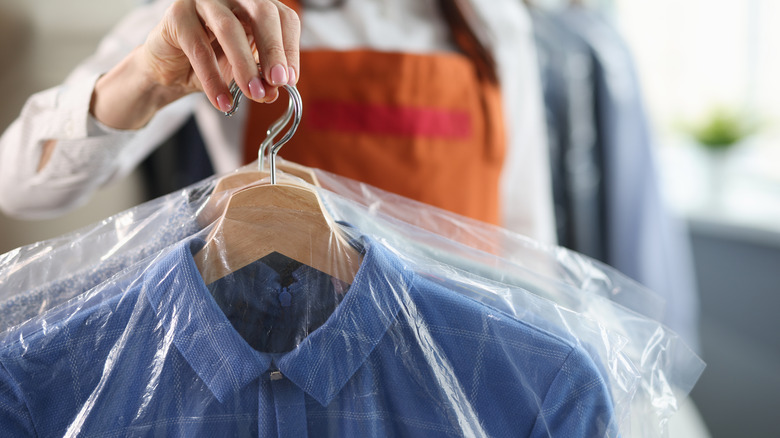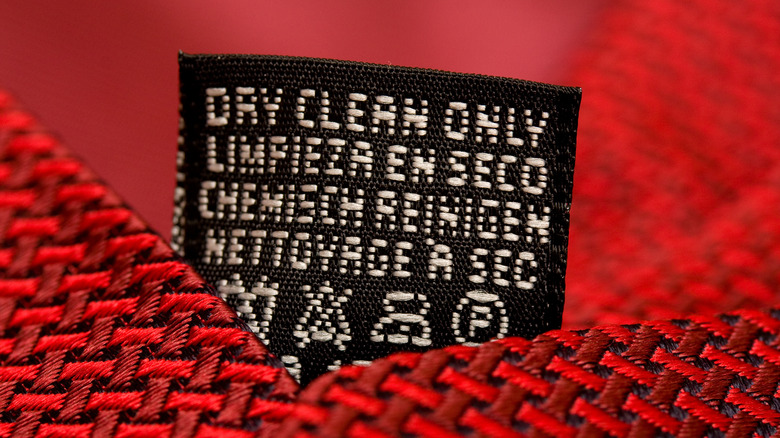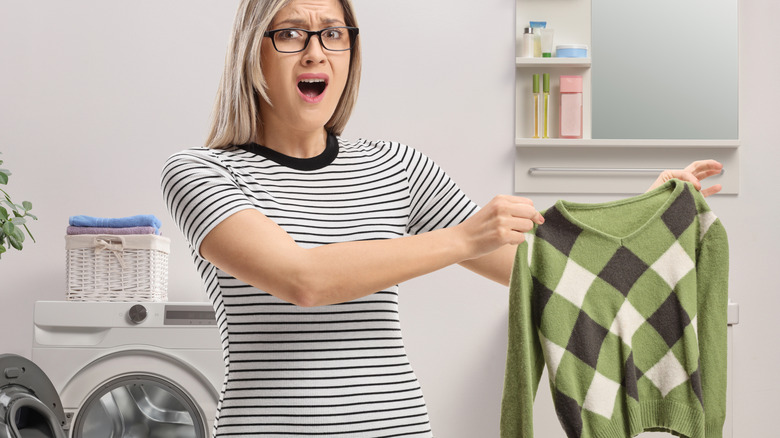How To Tell If You Really Need To Dry-Clean Your Laundry
You just scored a major deal on a high-priced designer comforter, but will the cost of getting it dry-cleaned negate the savings? Considering you'll be digging into your wallet each time it needs washing, you may wonder if your bargain is more bust than boom. Moreover, you may be questioning if it really needs to be dry-cleaned at all. The answer isn't always cut and dried. Figuring out if you really need to dry-clean your laundry boils down to decoding the care label and determining whether or not you can safely wash it at home.
Having an expert clean your dirty laundry isn't cheap. Remember the aforementioned comforter you got a screaming deal on? Depending on the bedding's size and material, as well as the dry cleaner's location, professionally laundering a comforter can set you back upward of $50. And that's just for a single cleaning. Dry-cleaning coats, suits, dresses, and draperies cost a pretty penny as well. Fortunately, there are ways to save on your dry-cleaning bill without compromising the integrity of your favorite pieces.
Read between the label's lines
To determine if you really need to dry-clean a piece of laundry, start by reading the care instructions printed on the item's label. Take note — there's a difference between "dry clean" and "dry clean only." Interpret the former as a suggestion, while the latter should be considered law. If the tag is missing, you'll need to play laundry detective by assessing the item's fabric and construction. Leather, suede, velvet, wool, taffeta, silk, acetate, and items featuring fur, down, and embellishments like beads or sequins are vulnerable to damage if cleaned improperly. You've likely seen these delicate fabrics categorized as things that you should never wash in your laundry machine. Likewise, structured pieces like curtains, suits, ties, pleated skirts, or blazers with shoulder pads should be professionally dry-cleaned to preserve shape and fit.
Given that "dry clean" is code for recommended, but not necessarily required, you may be tempted to hand-wash items sporting a "dry clean" label. However, before you toss your beloved garment into the sink, conduct a spot test to check for colorfastness. To do so, simply combine a drop of mild detergent with a cup of water. Next, dip a cotton swab into the mixture and dab it on the underside of your garment, such as an interior seam or hem. As you gently pat the swab on the fabric, check for color transfer and bleeding. If the fabric's dye stains the swab or you notice any damage to the material, don't attempt to wash it yourself; it requires professional care.
Professional dry-cleaning alternatives
Manufacturers often label garments "dry clean only" if the fabric has not been preshrunk. Translation: If you wash your beloved article of clothing with water, it may drastically shrink or suffer irreversible damage. This includes garments made with mixed materials, such as a tweed sports coat lined with silk or acetate. While tweed may not be negatively affected by water, acetate doesn't respond as well, and you may end up with a distorted jacket with warped lining. Dry cleaning uses chemicals in place of water to remove stains and disinfect fabric items.
These days at-home dry cleaning is possible with the help of specialty kits. Similar to professional dry cleaners, the store-bought kits use chemical solvents to get fabrics clean. In theory, the chemicals interact with heat from your dryer to lift stains and sterilize clothes. While convenient, the kits aren't as precise as the experts and may not be as effective in removing oil-based stains.
Another option is to invest in the new high-tech item HGTV's Jonathan Scott thinks will become a laundry room staple: a steam closet. The state-of-the-art appliance uses steam to clean, deodorize, and freshen fabric items without harsh chemicals. While it may not sport the muscle of a traditional dry cleaner, it does accommodate delicate fabrics. However, affording a home steam closet could mean cleaning out your entire laundry budget and then some.


